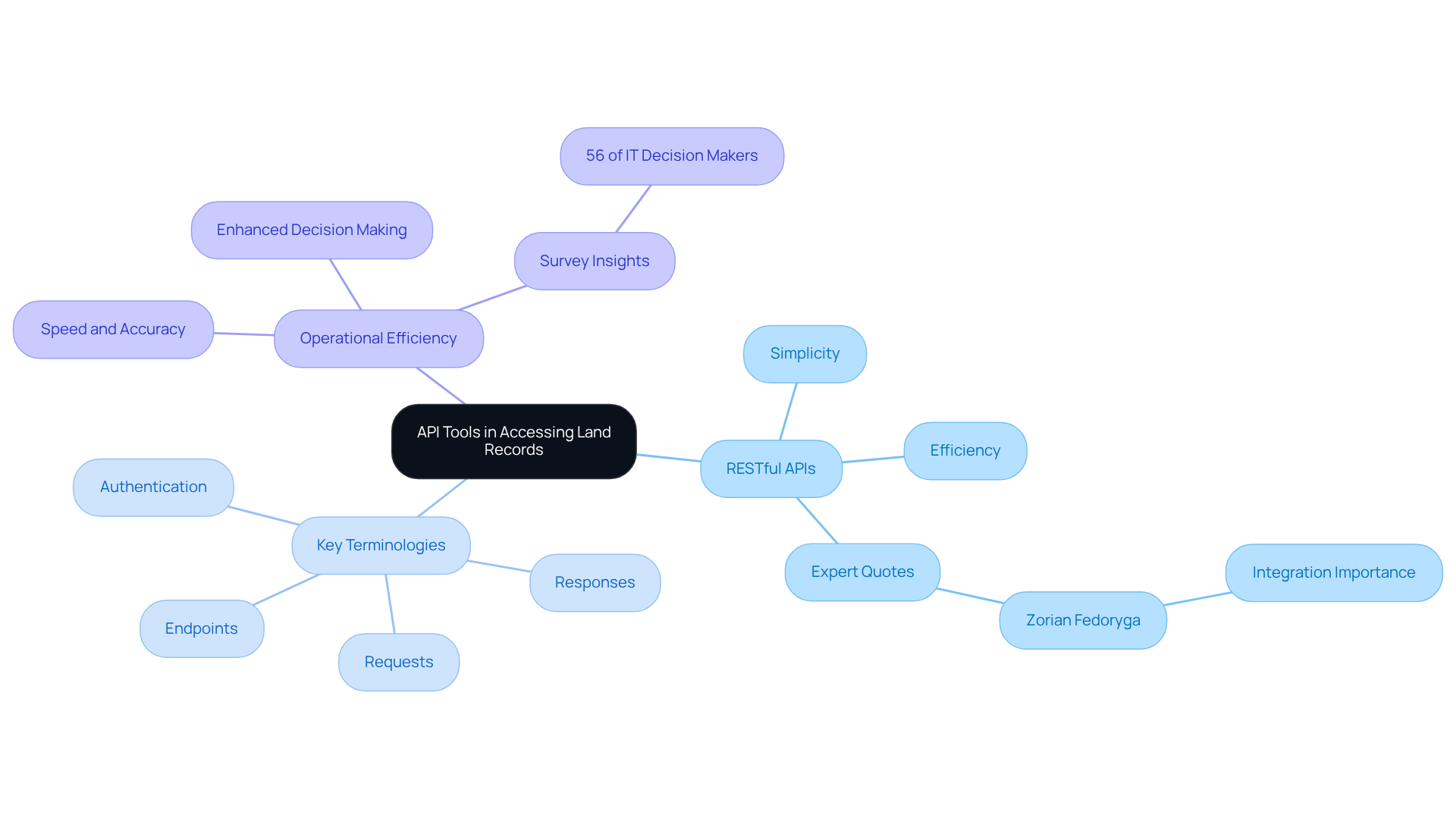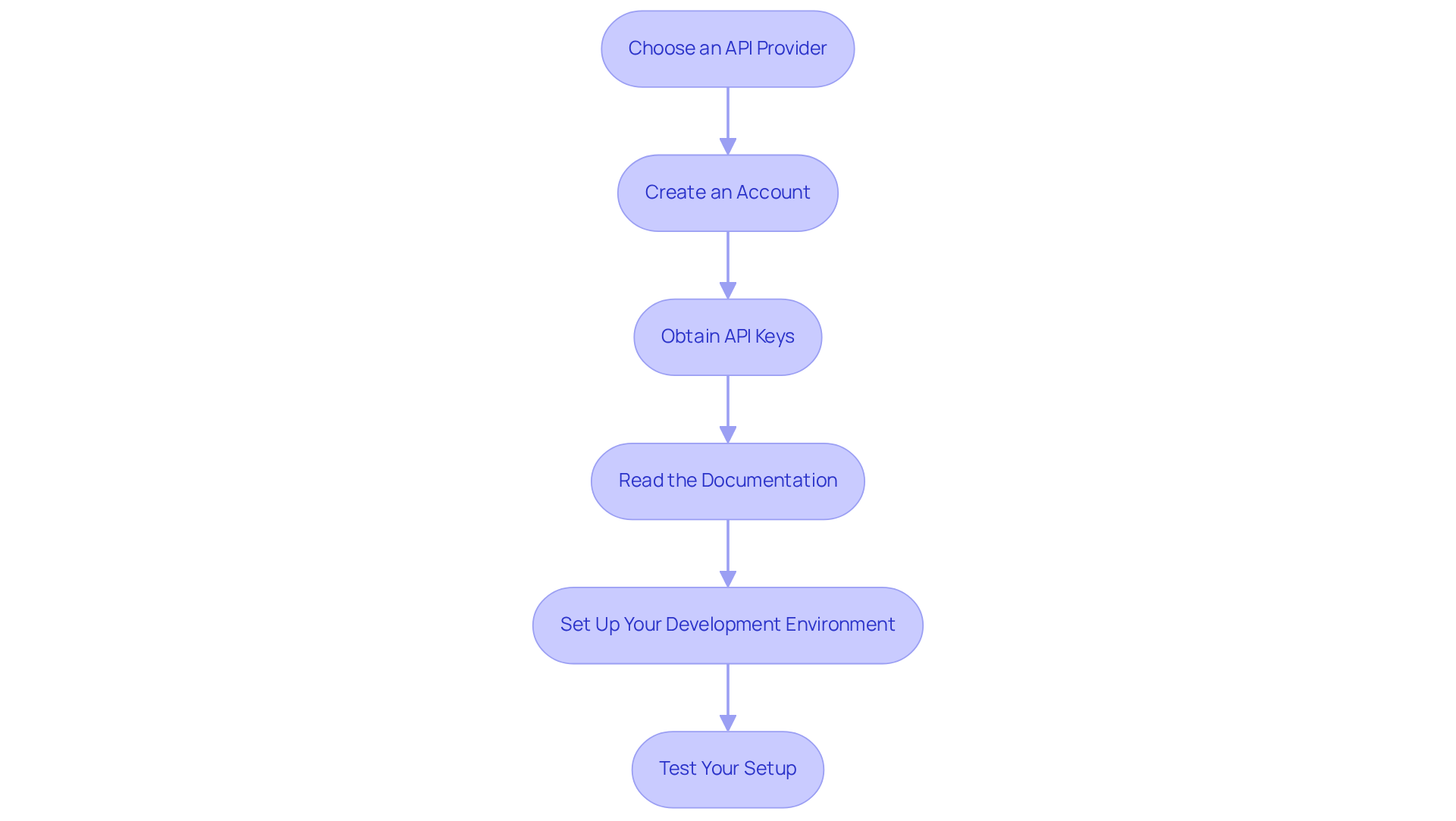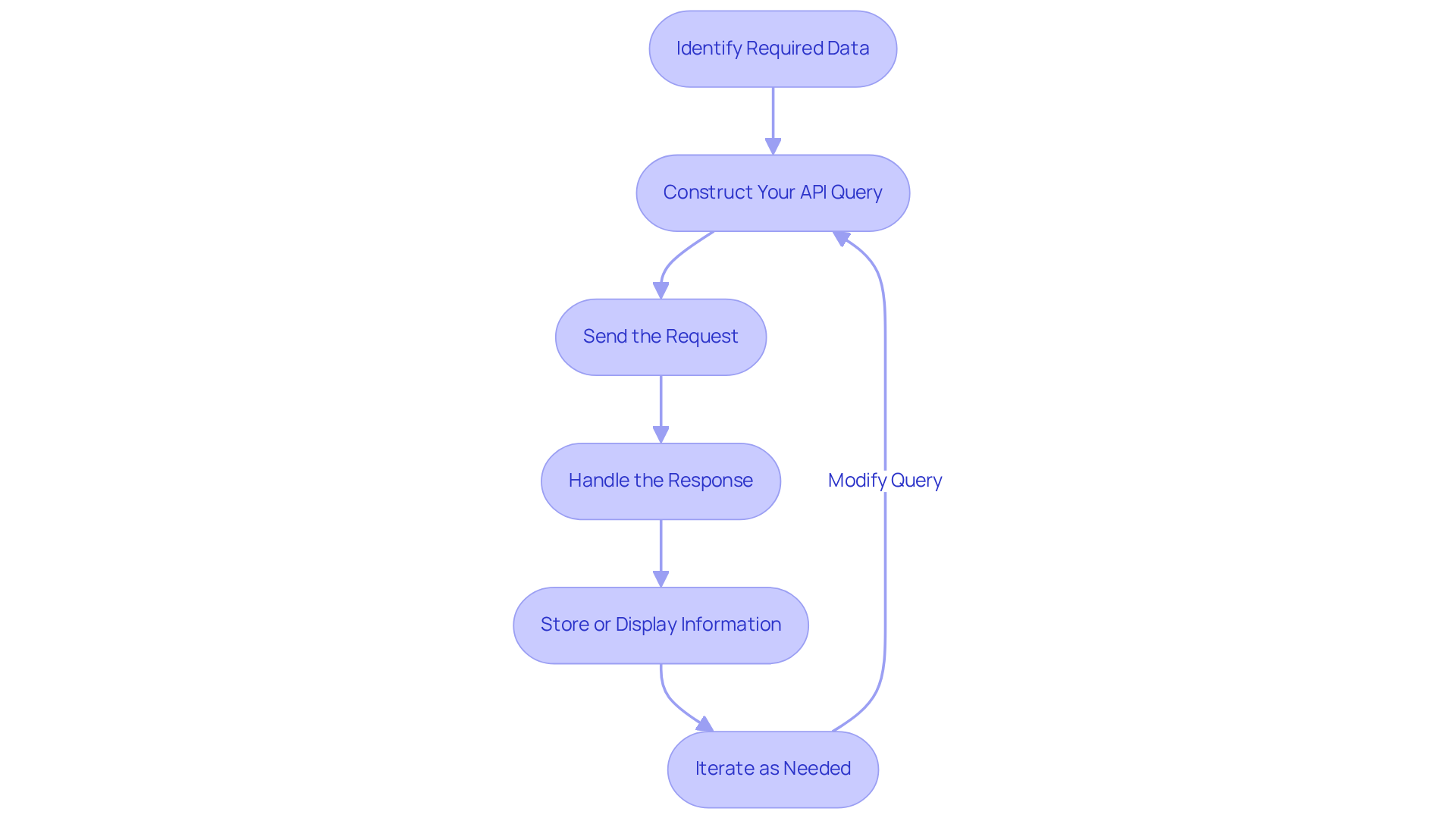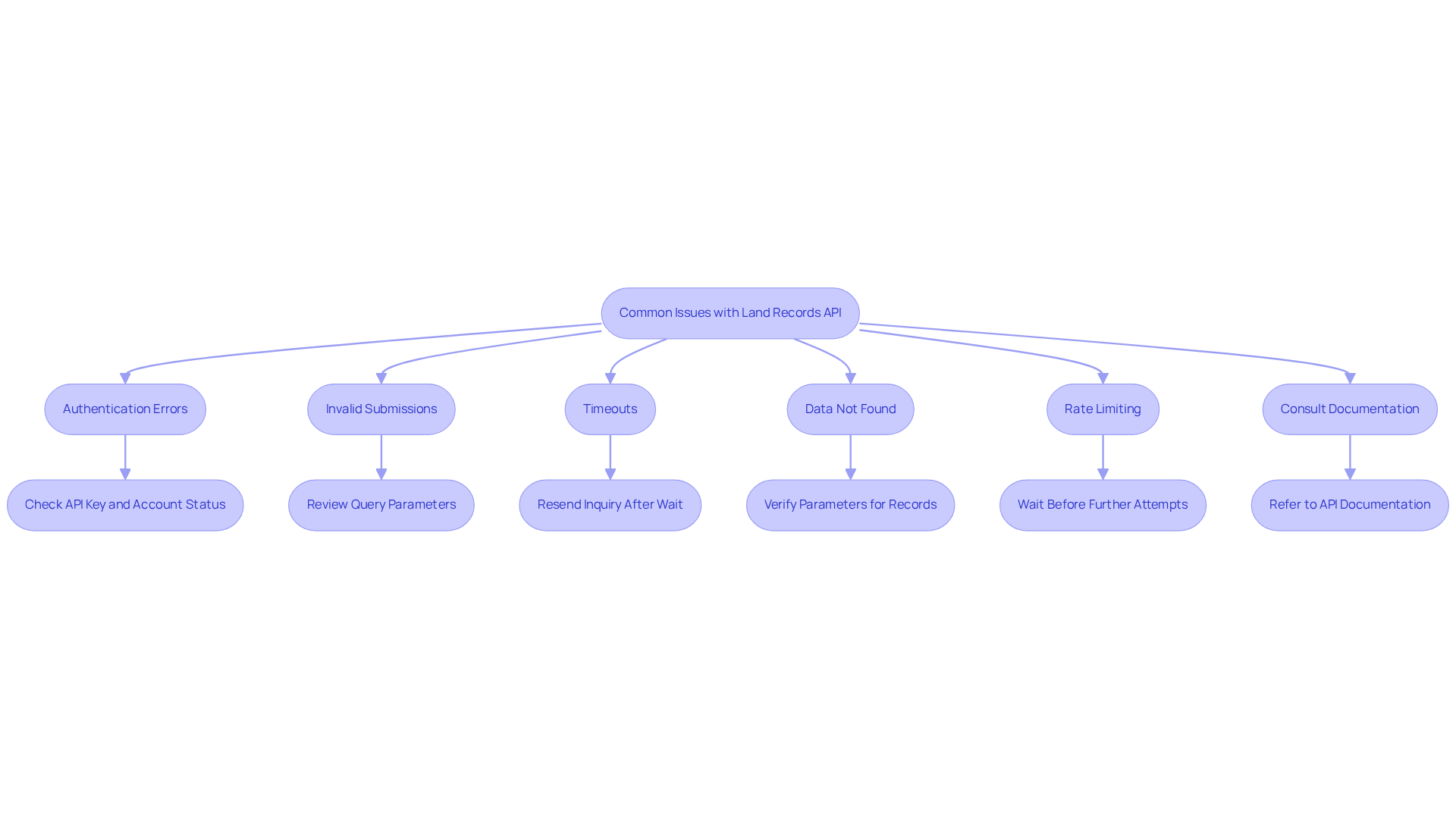Overview
Mastering API tools for accessing land records significantly enhances efficiency, enabling real estate professionals to retrieve critical information swiftly and accurately, without the need for manual intervention. This article underscores the importance of understanding RESTful APIs and their functionalities, which streamline data access and improve operational workflows. Consequently, this leads to better-informed decision-making in real estate practices.
Introduction
Navigating the complexities of land records can be a daunting task for real estate professionals, particularly when relying on traditional methods. However, the emergence of API tools presents a transformative solution, streamlining access to vital land information with unprecedented efficiency. As the industry increasingly recognizes the critical role of APIs in enhancing operational workflows, a pressing question arises: how can professionals effectively harness these tools to optimize their land record retrieval processes? This guide delves into essential steps and strategies for mastering API tools, ensuring that users navigate the digital landscape of land records with confidence and ease.
Understand API Tools and Their Role in Accessing Land Records
APIs, or Application Programming Interfaces, serve as crucial intermediaries that facilitate communication between diverse software applications. For real estate professionals, [API tools for accessing land records](https://parseai.co/solutions/property-records) streamline the retrieval of essential land information from various databases, effectively eliminating the need for manual intervention.
RESTful APIs, renowned for their simplicity and efficiency, offer distinct advantages in this context. They manage inquiries and replies with ease, making them a preferred choice for utilizing API tools for accessing land records. As Zorian Fedoryga, CTO of Parse AI, asserts, "If you’re not integrating APIs now, you’re already losing ground." By grasping the functionalities of RESTful APIs, real estate professionals can identify the most suitable tools tailored to their specific needs.
A solid understanding of key API terminologies—such as endpoints, requests, responses, and authentication methods—empowers users to navigate the API landscape proficiently. This knowledge not only accelerates the speed and accuracy of land access but also significantly . A recent survey found that 56% of IT decision-makers recognize the essential role that APIs play in enhancing [digital experiences and products](https://appwrk.com/api-documentation). Industry leaders consistently emphasize that the integration of API tools for accessing land records is vital for modern real estate practices, enabling professionals to access timely information and make informed decisions.

Set Up Your API Tools for Land Records Access
To set up your API tools for accessing land records, follow these essential steps:
- Choose an API provider that offers API tools for accessing land records tailored to your specific requirements. Significant choices comprise ATTOM Data Solutions, Zillow API, and Surepass Land Record Check API, which serve as API tools for accessing land records, each offering distinct features and information sets. Utilizing these tools can significantly , akin to the improvements seen in utility management solutions.
- Create an Account: Register for an account with your selected API provider. This process typically requires basic information and acceptance of their terms of service.
- Obtain API Keys: Once your account is established, navigate to the API section of the provider's website to generate your API keys. These keys are essential for verifying your inquiries and ensuring secure access to the information.
- Read the Documentation: Thoroughly review the API documentation provided by the service. This resource will detail endpoints, request formats, and response structures, which are vital for successful integration.
- Set Up Your Development Environment: Depending on your technical expertise, you may need to configure a development environment. This could involve using tools like Postman for testing API calls or integrating the API into your existing applications with programming languages such as Python or JavaScript.
- Test Your Setup: Before proceeding with data retrieval, perform several test calls to confirm that your setup is operational. Utilize sample endpoints from the documentation to ensure a successful connection to the API. By ensuring your setup is efficient, you can streamline your workflows, similar to the benefits seen in personalized GIS solutions.

Retrieve Land Records Using API Queries
Once your API tools are set up, you can efficiently retrieve land records by following these steps:
-
Identify the Required Data: Clearly define the specific land records you need, such as ownership details, property boundaries, or tax information.
-
Construct Your API Query: Refer to the API documentation to build your query. This typically involves specifying the endpoint and including parameters like location, property type, or ownership status. For instance, a query might look like this:
GET https://api.example.com/landrecords?state=CA&city=LosAngeles -
Send the Request: Utilize a tool like Postman or your preferred programming language to send the API request. Ensure that your API key is included in the headers for authentication.
-
Handle the Response: Upon receiving a reply, parse the information to extract the relevant details. Most APIs provide information in JSON format, which is compatible with most programming languages, making it straightforward to work with. As Cem Dilmegani, Principal Analyst at AIMultiple, observes, "Effective information retrieval is crucial for real estate professionals to make informed decisions swiftly."
-
Store or Display the Information: Depending on your requirements, you can either save the retrieved information in a database for future reference or show it directly in your application for immediate use. Statistics indicate that organizations utilizing API tools for accessing land records experience an average response time decrease of 30%, significantly improving workflow efficiency.
-
Iterate as Needed: If you need extra entries or alternative information points, modify your query parameters and redo the process. This iterative method enables thorough customized to your specific requirements. Mert Palazoğlu, an industry analyst, emphasizes, "The ability to adapt queries based on evolving needs is essential for maximizing the value of land information data.

Troubleshoot Common Issues When Accessing Land Records
When using , several common issues may arise. Here’s how to effectively troubleshoot them:
- Authentication Errors: Encountering an authentication error necessitates a check of your API key to ensure it is included in your headers. Confirm that your account is active and that you have not exceeded your usage limits. Invalid authorization often results from incorrect API keys or tokens; therefore, reviewing your credentials is essential. Industry experts assert that keeping your API keys up-to-date can prevent many common authentication issues.
- Invalid Submissions: A 400 error indicates an invalid submission. Review your query parameters for correct formatting and ensure that you are using valid endpoint URLs. Common causes of invalid submissions include missing or incorrectly formatted fields, which can lead to frustrating delays in accessing necessary data. A recent study revealed that nearly 30% of erroneous submissions in the API tools for accessing land records stem from improperly formatted parameters.
- Timeouts: If your inquiry times out, it may be due to server issues or network problems. Resend the inquiry after a brief wait, or consult the API provider's status page for any reported outages. Understanding the frequency of invalid requests can help you gauge whether the issue is widespread or isolated.
- Data Not Found: A 404 error suggests that the requested data does not exist. Verify the parameters you are using to ensure they correspond to available records. This verification is crucial, as incorrect parameters can lead to unnecessary troubleshooting efforts. Case studies have shown that many users encounter 404 errors due to simple parameter mismatches.
- Rate Limiting: Many APIs enforce rate limits on the number of calls permitted within a specific timeframe. If you reach this limit, you will need to wait before making further attempts. Consult the API documentation for specific limits and best practices to avoid hitting these thresholds. Developers frequently report that understanding these limits can significantly enhance their API interaction efficiency.
- Consult Documentation: Always refer back to the API documentation for guidance on error codes and troubleshooting steps. Most providers offer detailed explanations of common issues and their resolutions, which can significantly streamline the troubleshooting process. Utilizing tools like Postman can also aid in identifying errors by comparing requests against saved examples. As highlighted in various case studies, a thorough review of documentation is key to effectively resolving API issues.

Conclusion
Mastering API tools for accessing land records is crucial for real estate professionals aiming for efficiency and accuracy in their operations. By leveraging these powerful interfaces, users can significantly reduce the time spent on manual data retrieval, facilitating quicker decision-making and enhancing productivity. Understanding the role of APIs, particularly RESTful APIs, marks the first step toward optimizing land record access and management.
Throughout this discussion, key insights are provided on the setup and utilization of API tools. From selecting the right API provider to constructing effective queries and troubleshooting common issues, each step is crafted to ensure seamless access to vital land information. The focus on grasping API terminology and best practices underscores the necessity of a solid foundation in API usage to maximize operational efficiency.
In conclusion, embracing API tools not only streamlines the process of accessing land records but also positions real estate professionals to remain competitive in a rapidly evolving market. As the demand for quick and reliable information escalates, integrating these tools into daily operations becomes increasingly critical. Taking action today to master API tools will pave the way for a more efficient and informed approach to land record management, ultimately driving success in the real estate industry.
Frequently Asked Questions
What are APIs and their role in accessing land records?
APIs, or Application Programming Interfaces, act as intermediaries that facilitate communication between different software applications. For real estate professionals, API tools streamline the retrieval of essential land information from various databases, eliminating the need for manual intervention.
What type of APIs are preferred for accessing land records?
RESTful APIs are preferred for accessing land records due to their simplicity and efficiency. They manage inquiries and replies with ease, making them a popular choice for this purpose.
Why is it important for real estate professionals to integrate APIs?
Integrating APIs is crucial for real estate professionals as it enhances their ability to access timely information and make informed decisions. Not integrating APIs can put professionals at a disadvantage in the competitive market.
What key terminologies should users understand when working with APIs?
Users should understand key API terminologies such as endpoints, requests, responses, and authentication methods. This knowledge helps users navigate the API landscape more proficiently.
How do APIs impact operational efficiency in accessing land records?
A solid understanding of APIs accelerates the speed and accuracy of land access, significantly enhancing overall operational efficiency for real estate professionals.
What do industry leaders say about the role of APIs in real estate?
Industry leaders emphasize that the integration of API tools for accessing land records is vital for modern real estate practices, as it allows professionals to access essential information quickly and make better decisions.




